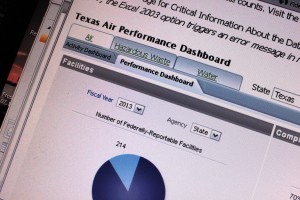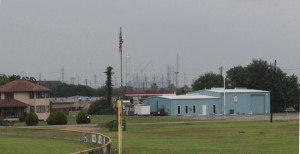Texas Slams EPA Website that Compares State Pollution Enforcement

Dave Fehling / StateImpact
The EPA's ECHO website uses data from state pollution regulators to compare compliance and enforcement
Compared to other states, Texas has a consistently higher percentage of major industrial plants with “high priority violations” of air pollution laws. Yet, compared to other states, Texas does far fewer comprehensive inspections of polluting facilities.
Or at least, that’s what data seem to show on website run by the U.S. Environmental Protection Agency.
Not surprisingly, Texas, with a history of fighting the EPA at every turn, says the website has “tremendous potential” for being misleading, deceiving, and inaccurate.
The site is called ECHO for Enforcement and Compliance History Online. The EPA launched it in 2002. The goal was to give the public access to data on how state and federal regulators were enforcing pollution laws. The site not only allows access to detailed compliance reports for specific facilities, it also allows a comparison of enforcement action by state.
An audit of the site in 2010 found that its data were “91.5 percent” accurate. The EPA updated ECHO in 2011 and again this year.

Dave Fehling / StateImpact
Melanie Oldham and Sharron Stewart in Lake Jackson are featured in the AUDIO story
One graph on the ECHO site shows the percentage of major industrial plants with what the EPA calls High Priority Violations (HPV) of air pollution laws. It says in 2010, nearly 10 percent of big plants in Texas had HPVs compared to a national average of about 6 percent. The Texas number decreased a bit by 2013 but remained above average.
Another graph shows that Texas took enforcement action against major facilities at about the same rate as the national average and issued penalties in almost all such cases whereas the national average for issuing penalties was 80 percent.
Texas-style Voluntary Compliance
But other data raise questions about just how hard Texas regulators look for violations. ECHO data show that in some recent years, Texas did full inspections on less than 20 percent of major industrial facilities compared to a national average of around 60 percent.
Those figures seem to confirm what critics say about Texas-style regulation: by favoring voluntary compliance over strict enforcement, the result is too little oversight that lets too many polluters go unpunished.

Dave Fehling / StateImpact
New petrochemical facilities going up in Freeport
“And you can blame the legislature. The legislature does not fund enough people and equipment. But it’s worse than that, there’s too much fox guarding the hen house in the state of Texas,” said Sharron Stewart, a long-time environmental activist who lives in Lake Jackson, a city south of Houston and next to a huge petrochemical complex.
In Texas, the chief enforcer of pollution laws is the Texas Commission on Environmental Quality. The Texas legislature slashed the TCEQ’s budget by 30 percent.
Nonetheless, in its most recent report on its environmental enforcement efforts, the agency says it has made “significant accomplishments”. It says it did over a 100,000 investigations last year and issued nearly 13,000 violation notices.
But the report also says that illegal releases of pollution were up 6 percent statewide and that the number of investigations actually decreased slightly compared to the previous year.
TCEQ: Don’t Trust the EPA
As to how the TCEQ is compared to national averages on the ECHO site, the TCEQ contends the site cannot be trusted.
“An accurate, comprehensive picture of the compliance and enforcement efforts undertaken by the TCEQ is not presented on the ECHO website,” wrote Terry Clawson in an emailed response to StateImpact. Clawson is TCEQ’s media manager.
“There is a tremendous potential for generating misleading data when comparing state enforcement numbers, because rules and regulations, levels at which investigations are triggered, levels of industrialization, population and many other factors vary widely from state to state. Using percentages can be deceiving when comparing a state like Texas with other states or a national average,” wrote Clawson.
As to why ECHO shows Texas doing far fewer “Full Compliance Evaluations” of polluting facilities, Clawson said the site’s graphs do not display “other inspection activities TCEQ conducts”.
The EPA doesn’t completely disagree.
“It is true that states perform other activities that aren’t included in calculating charts on the dashboards,” wrote Jennifer Colaizzi in an emailed response. Colaizzi is a press officer at EPA’s Washington headquarters.
However, Colaizzi maintained that ECHO relies on data reported to the EPA by the states themselves “so information for these charts should be complete”.
“The ECHO Dashboards provide a general look at environmental compliance and enforcement trends on a state and national level,” wrote Colaizzi.

